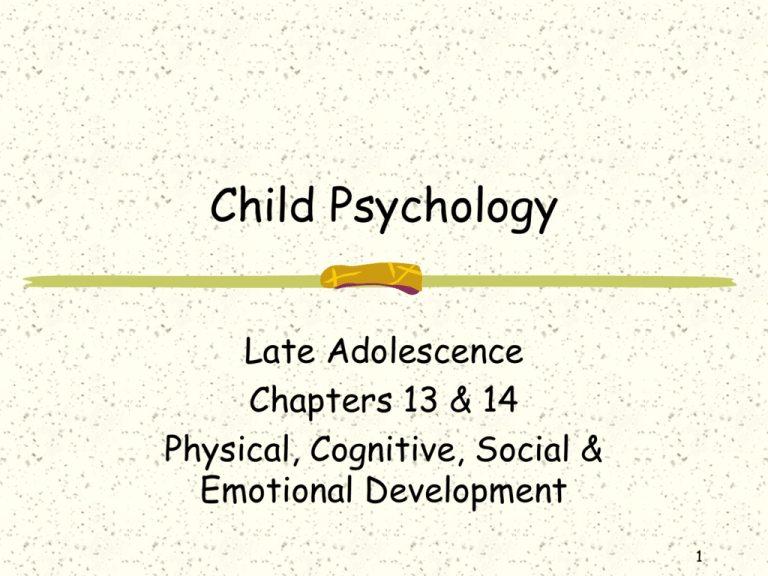
Child Psychology
Late Adolescence
Chapters 13 & 14
Physical, Cognitive, Social &
Emotional Development
1
Agenda
Health & safety issues
Cognitive development
Gender differences in self-esteem &
gender research in general
Autonomy, sexuality, & consequences
Adolescent psychopathology
2
Health & safety issues
Accidents
Homicides
Suicide
Sexually Transmitted Diseases
3
Accidents & Homicide
First and second leading causes of
death of 15-24 year-olds
Accidents
High rates of risky behaviors
New drivers = poor drivers
Homicide
US: highest homicide rate
Unable to plan & weigh consequences
4
Suicide Risk Factors in
Adolescents
A psychiatric problem, antisocial
behavior, substance abuse
Belonging to a family with a history of
suicide
Experiencing high levels of stress
Experiencing family problems or high
levels of family conflict
5
Sexually Transmitted Diseases
Diseases that may be transmitted from one
person to another through sexual contact
Teen STD risk factors:
Multiple sexual partners rather than a single
long-term relationship
Unprotected sexual intercourse
High-risk partners
AIDS
Acquired immunodeficiency syndrome
6
Cognitive Development
Social cognition
Thinking about people and interpersonal
relationships
Social perspective taking
Understanding Other People’s
Perspectives
7
Gender Differences in Self-Esteem
Meta analysis
Purpose & techniques
Meta analysis: Gender Differences in
Self-Esteem
Gender & self-esteem became an
especially hot issue after AAUW study,
followed by two widely read books
How big is the difference?
8
Headlines
9
Reviving Ophelia
(94, 95 papback)
10
Failing at Fairness
(94, 95 papback)
11
AAUW study data – Sadker
12
No meta-analyses…until
O’Brien, Leitzel, Mensky, Jeffreys, O’Brien, &
Marchese (1996). Gender differences in selfesteem among adolescents: A meta-analysis.
104th annual convention of the American
Psychological Association, Toronto.
129 effect sizes from 80 studies
two individuals rated each
represented 71,113 subjects
mean d value across studies was 0.20, 0.22
corrected for reliability of measures
13
Theoretical overlap
14
Military adolescent data
15
Misconceptions about sex differences
Eagly, A. (1995) The science and
politics of comparing men and women.
American Psychologist, 50, 145-58.
Sex differences are small
Sex differences are quite inconsistent
across studies
Sex-differences are artifactual
Sex-difference findings disconfirm
gender stereotypes
16
Misconceptions: sex differences
Sex differences are small
in general the findings with respect to sex differences
are effects in the small to medium range that is fairly
typical of psychological research generally
large effects are unusual in gender comparisons, as they
are in psychological research generally.
Sex differences are inconsistent across studies
Inconsistencies across studies no more than is typical
across many areas of psychological research
Growing awareness that just about everything we
measure in psychology is context dependent in some way
17
Misconceptions: sex differences
Sex-differences are artifactual
Publication bias for significant findings
Gender differences are often peripheral to main aims of study
Gender of author(s) – significant in some areas of social
psychology (conformity & gender) not in meta-analysis of SE.
Sex-difference findings disconfirm gender stereotypes
Differences favor males in:
Aspects of visuospatial ability
Agentic behavior, dominant, controlling, independent
Females favored in:
Measures of verbal fluency
Communal behavior, socially sensitive, friendly, concerned with
others welfare
18
Conclusion
Gender differences research
Magnitude and consistency of
differences across studies very similar
to most areas of inquiry in psychology
19
Development of Autonomy
Emotional autonomy
understands oneself as a person who is
emotionally distinct from one's parents
Behavioral autonomy
can make and follow through with decisions
regulating one's behavior
Values autonomy
makes judgments and choices about personal
beliefs and principles
Factors that Contribute to Adolescent
Autonomy
20
Adolescent Sexual Development
Double standard
Adolescent contraceptive use success
information
acknowledging likelihood of sex
obtaining contraception
communication with partner
using correctly
Teen Pregnancy
21
Adolescent Sexual Devel. (cont.)
Effective sex ed. programs:
communication, negotiation, and refusal skills
reduce behaviors leading to preg. or STDs
basic, accurate information
address social and media pressures re: sex
Adolescent parents often exhibit
Lack of knowledge about child development
Anxiousness and frustration about parenting
Little interaction with infants
Negative exchanges with their children
Negative attitudes toward parenting
22
Problems of development
Delinquency
< 21 year olds account for 30% of arrests in US
Factors related to delinquency
Gender
Difficult temperament
Low intelligence
Peer rejection in childhood
Family environment
Prevention and treatment
Early and targeting parents, schools and communities
Treatments that work include teaching cognitive and
social skills to assist in overcoming difficulties
23
Problems (con’t)
Depression
Symptoms
Factors related to depression
Genetics
Parental depression (maladaptive parenting)
Learned helplessness
Gender differences
Suicide
Second or third leading cause of death
Gender differences
24
Adolescent Psychopathology
Lewinsohn, P.M., Hops, H., Roberts, R.E., Seeley,
J.R., & Andrews, J.A. (1993). Adolescent
psychopathology: I. Prevalence and incidence of
depression and other DSM-III-R disorders in
high school students. Journal of Abnormal
Psychology, 102(1), 133-144.
Randomly selected sample of high school students
n=1,710 at point of entry and 1,508 at 1-yr followup
Western Oregon, Eugene area
Representative sample
Clinical interview
Very expensive study
25
One year incidence of mental disorders in adolescents
One year incidence
12
Female
Male
10
Total
percent
8
6
4
2
0
Depression
diagnosis
Anxiety
Disorder
Disruptive
Behavior
Dis.
Substance
Use Dis.
Eating
Disorder
Adjustment
Disorder
Data from Lewinsohn, P. M., Hops, H., Roberts, R. E., Seeley, J. R., & Andrews, J. A. (1993). Adolescent
psychopathology: I. Prevalence and incidence of depression and other DSM- III- R disorders in high school students.
26
Prevalence rates of mental disorders in adolescence
Prevalence of disorders
25
Point
prevalence
Lifetime
prevalence
20
percent
15
10
5
0
Depression Bipolar Dis.
diagnosis
Anxiety
Disorder
Disruptive
Behavior
Dis.
Substance
Use Dis.
Eating
Disorder
Adjustment
Disorder
Data fro m Lewinso hn, P . M ., Ho ps, H., Ro berts, R. E., Seeley, J. R., & A ndrews, J. A . (1993). A do lescent psycho patho lo gy: I. P revalence and
incidence o f depressio n and o ther DSM -III-R diso rders in high scho o l students. Jo urnal o f A bno rmal P sycho lo gy, 102(1), 133-144.
27
General findings
almost 10% - current psychiatric disorder
nearly 40% had experienced disorder
during lifetime
females experienced greater incidence
most common: depression, anxiety
disorders, substance abuse, and disruptive
behavior disorders
indicates need for stronger prevention
efforts
28






